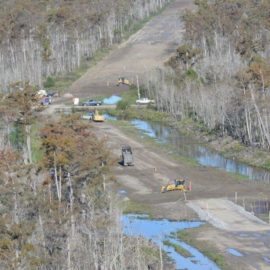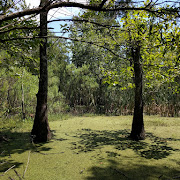
Maurepas Swamp is a typical swamp but it need to be revitalized.
It is a scene straight out of Louisiana lore, a seeming exemplar of swamp life: Craggy cypress trees, moss dangling from their branches, stretch out for thousands of acres atop dark, shallow waters. But a quick glance does not do it justice. In fact, the Maurepas Swamp, covering a vast area between New Orleans and Baton Rouge, is dying. “It’s been dying for almost a century now,” Brad Miller, project manager with the state Coastal Protection and Restoration Authority, said before boarding a boat to traverse the Blind River into the swamp last week. “And the thing with swamps is, it happens really, really slow.”
nola.com

This wikll be done prior to the diversion.
Revitalizing a wide swath of the second-largest swamp in Louisiana has been discussed for at least a couple decades, but enough stars have finally aligned to allow the project to move forward. Work is expected to begin in the months ahead on a unique project that will inject freshwater from the Mississippi River, handing the swamp a new lease on life. The plan is expected to benefit around 45,000 acres – the size of around 35 New Orleans City Parks – and the aim is twofold: to improve the region’s storm protections while reviving an ecosystem that was once a prime spot for wildlife, as duck hunters will attest. Wetlands like the Maurepas Swamp are capable of knocking down storm surge, and working to restore them has been a hard lesson learned for hurricane-hit coastal Louisiana. “If you’re interested in hurricane protection, that’s the way to go – to build swamp,” said Gary Shaffer, a professor at Southeastern Louisiana University in Hammond who has studied the area and advocated for the project for more than 20 years.
This has been a years long desire but the stars seem to be lining up.
For Miller and Shaffer, the project may have at times seemed elusive. But an unlikely set of circumstances means the state now hopes to start construction in the summer, at an estimated total cost of around $300 million. One factor that helped was a first-of-its-kind decision by the Army Corps of Engineers announced last month to allow the project to serve as mitigation for environmental damage being caused by the construction of a major levee project nearby, known as the West Shore Lake Pontchartrain hurricane protection system. That will shave off some of the bill for the state’s 35% share of the cost of the levee project. Another key was settlement money related to the 2010 BP Deepwater Horizon oil spill, which will pay for about two-thirds of the swamp project. The state will cover the remainder.
This will also be a diversion from the Mississippi but a small one.
The project is a river diversion, but it differs greatly from the planned large-scale diversions aimed at rebuilding coastal land. This one will be relatively small, capable of channeling up to 2,000 cubic feet per second. Compare that to the capacity of the Bonnet Carre Spillway, which can reach 250,000 cfs. A new two-mile channel constructed near Garyville will direct the water into the Hope Canal, then into an outfall area in the swamp north of Interstate 10. Construction will be done in conjunction with the nearby levee project and is expected to take about four years. The idea is to reconnect the swamp to the Mississippi River and the nutrients it once provided. The levees now hold the river in place instead of allowing its waters to overflow and its course to meander as happened earlier in history – necessary to keep the region from flooding, but badly damaging wetlands and coastal marsh. In the Maurepas Swamp, that has meant dying trees, sinking land and a decline in wildlife. The swamp has thinned out, with less canopy than it should have. The legendary duck hunting of the past is no more – a sign of deeper problems with the habitat.
Swamps are needed here and this one will help.
The diversion will go a long way in beginning to nurse the swamp back, state officials and activists say. Its effects will be closely monitored to determine whether it’s working as intended. “This is a huge deal,” Alisha Renfro, a coastal scientist with the National Wildlife Federation, said during a stop on last week’s boat tour of the swamp. “It’s 20 years in the making to actually get us here.” Chris Macaluso, director of marine fisheries for the Theodore Roosevelt Conservation Partnership, spoke of the project revitalizing an area easily accessible to residents in the New Orleans and Baton Rouge areas. Louisianans drive past it on the I-10 everyday without realizing. “I did a lot of duck hunting in those swamps around Sorrento, and it’s a noticeably different habitat now than it was, say, 30 years ago,” he said.
This is a beginning as more needs to be done.
But while those who have long studied the swamp strongly back the project, Shaffer notes larger diversions will be needed to more fully restore wetlands there and in the wider Pontchartrain Basin. Still, Shaffer said, “no matter what, it will help a lot.” While the swamp has degraded over the years, it still offers striking views. During last week’s tour, a flock of roseate spoonbills perched on tree branches. Nearby, a carefully maintained chapel called Our Lady of Blind River stood on stilts, a statue of the Virgin Mary keeping watch inside. Laramie Hill, 41, a commercial crabber in Lake Maurepas, remembers the stories his father-in-law used to tell him about trapping muskrat in the swamp. “They would crab and fish all summer until around Thanksgiving, and then they would just full-time trap,” he said, adding that they would also see thousands of ducks, unlike today.
This project is one we need south of us to get a swamp to protect us but is there enough land?


